Rollersoccer Goalie Fundamentals
This article presents some fundamental concepts about how to play
the position of goalie in rollersoccer.
As goalie you are the last chance to stop a goal. You must follow
the action as it develops and constantly reposition yourself for
maximum defensive advantage. Sometimes this means shifting left
or right, sometimes it means falling back toward the goal or charging
at an opponent. Sometimes your only defense is to "take on" the
opponent rather than waiting for them to take a shot on goal.
As a rollersoccer goalie you may not use your hands except to
protect yourself from injury, but, only shots below your waist
(3 feet) can count as a goal. So, you must learn to stop the ball
with your feet, legs and hips. Of these, your feet are the
most maneuverable. Imagine kicking a ball that is flying through
the air toward you. You don't actually have to kick the ball
very hard -- just touching the ball is often enough to deflect it
enough so it will miss the goal left or right or above.
Like Hockey and Soccer, your physical position as goalie has a lot
to do with how successfully you can defend the goal. If you are
out of position you might not even be able to tell, but your
opponent has a clear view of your position and will take advantage
of it if possible.
In the diagrams below you are the green square, your opponents
are red, and the goal posts are blue. Where necessary the ball
is depicted as black. Potential shots on goal are lines with an
arrow head, while passes have no arrow head. You have a line
running through you which represents how far your feet can move
side to side to block a shot.
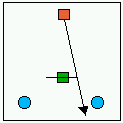 |
You should begin halfway between the two goal posts, as shown in
figure A. Notice that you cannot cover the entire goal in this
position. An opponent can kick the ball to either side of you
and score a goal.
|
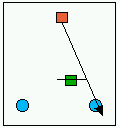 |
You could shift to the right (or left) if you knew that your
opponent is going to take a shot in that direction, but you'll
soon realize that they will try to "fake you out", to make you
think they are going to kick one direction, but then they will
kick in the other direction, which is now wide open.
|
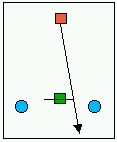 |
Moving back toward the goal is actually the worst thing you
can do when there is only one opponent, because it actually
makes more space available for a shot, not less.
|
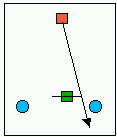 |
As you can see, shifting to one side when close to the goal
opens up a huge amount of space for a shot in the direction
where you aren't.
|
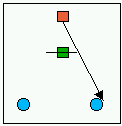 |
Instead, you must skate towards your opponent! This effectively
reduces the opportunity for your opponent to score a goal because
you will be able to block shots that could score. You don't need
to shift side to side at all if they are coming straight toward
the middle of the goal. Sometimes this means you will come into
contact with your opponent. In fact, if they do not take a shot
before you are very close to them, you should kick the ball away
from them. You don't need to worry about passing it or controlling
it -- just kick it. Don't hurt them! But disrupt their control
of the ball and "clear" the ball (get it out of your area).
Then get back into position immediately because another opponent
may control the ball quickly and try to take a shot while you
are out of position.
|
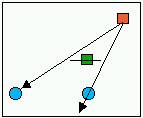 |
In fact, coming straight at you gives a single opponent their best
chance to score. But very often they will be coming from one side
or the other because that is where they received the ball. When
they approach from one side or the other they have a harder shot
to make because from their angle the goal appears narrower. This
works to your advantage because you can defend a narrower goal
more easily. You still use the same strategy -- you move toward
your opponent enough to cut off their chance to score a goal. But
you won't have to move forward quite as much to accomplish the
same thing you did when they were coming straight toward you from
the middle of the field.
After you get the hang of it, you should be able to stop almost
any single opponent, except maybe Kwame or Andy or Zack or Doug.
A very experienced opponent will shift their position quickly,
trying to catch you off guard, and if you charge them to cut off
their shot they may "dribble around you" (maneuver the ball around
you when you try to interfere with their shot).
|
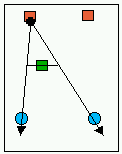 |
But handling a single opponent is only a part of the game. A
more organized rollersoccer team will send two players at a time
toward you. One with the ball and the other ready to receive
a pass at the discretion of the first player. If you simply try
to cut off the shot of the first opponent they will pass to the second
opponent who will have a clear shot.
You'll get a sense for how well the other team plays as a team. If they
have a lot of team players they will pass a lot. If they have a lot
of glory seekers they won't pass as much. But don't count on any one
behavior because they will adapt to your responses as well.
|
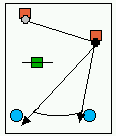 |
If you have committed to charging the opponent with the ball
they can easily pass it to their other player, who then will
have an easy shot on goal. In this diagram the entire goal
is open to the other player.
The truth is that when there are two players approaching you
and you have no other defenders to help you (where is the rest
of your team?) then they should be able to score a goal
on you more often than not. They definitely have the advantage.
That said, there are some things you can do to make it harder
for them.
|
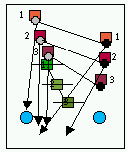 |
This diagram shows three consecutive points in time.
- One opponent has the ball and you move to block their
shot. They may pass the ball to the other player and they
have a shot on goal.
- You fall back to reduce the chances of the left opponent
scoring somewhat and if they pass you will also be in a bit
better position to reduce the other opponent's chances of scoring.
- You fall back even more to reduce the chances of the left opponent
scoring somewhat and if they pass you will also be in a bit
better position to reduce the other opponent's chances of scoring.
As you can see, all you've really been able to do by falling back
is to reduce the chances of scoring -- you haven't been able to
fully block the goal. So, this is a losing strategy.
|
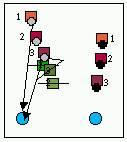 |
This diagram also shows three consecutive points in time, but
this time you don't just fall back in each case.
- You initially position yourself to discourage a direct shot by
the first opponent. This suggests to them that they should pass the
ball.
- Then you fall back slightly, as if you were going to follow
the plan from the previous figure, but this is you faking them
out because you do not fall back very far or for very long.
Very soon after you begin to fall back you aggressively charge
the opponent with the ball and instead of keeping your shoulders
square to the goal, you face your opponent at an angle and get
close to them, interfering both with their chance to shoot a goal
and to pass the ball to their team mate. If they try to pass all
you have to do is touch the ball and you will interfere with the
pass, giving your team a chance to get the ball and giving you
a chance to get back into position. to defend the goal.
You must be aggressive and may come into contact with the other
player. Don't hurt them! But do interfere with their ability to
pass the ball. If they are very good they will see you do this
and will try to move around you. In this diagram, the left player
might attempt to move around you further to the left. You
are already in position to take them on "one-on-one" and to
interfere with their ability to maneuver around you. Once you
are close enough to them they won't have an easy way to pass
or dribble around you.
|
You are often forced to pick a moment to charge an opponent. If
you wait too long you will have left open an chance for them to
score or pass to someone who can score. If you charge too soon
it will take you too long to reach them and they will have
plenty of opportunity to recognize your charge and decide what
to do about it. Once you decide to charge the goal is
vulnerable until you reach your opponent. During that period
they can pass or maneuver at will. The trick is to wait until
you can reach them quickly -- no more than a second. You can
lunge from your normal position and reach about 10' within a
second if you are prepared. A goalie usually has plenty of
time to catch their breath and use their anaerobic strength
to explode forward at just the right time.
To do this on skates requires that your feet are in such a position
that when you apply your leg strength your skates do not roll!
Practice running on your skates from a crouching position.
After a few steps you'll need to roll, but for the first few steps
you should be able to sprint. Your feet will be pointing out to
the sides almost 90 degrees for these first few steps.
Being able to run a few steps on your skates without rolling
allows you to use all of your leg strength to charge your
opponent.
You must also be able to stop very quickly. The best way to
do this is with the "hockey stop" technique. This is described
elsewhere.
It is very challenging to charge explosively toward your opponent
and then stop right in front of them. I try to hockey stop through
the ball. That is, I plan to stop about a foot past where the
ball is, so the act of stopping also brings my skates in contact with
the ball. You must be careful to go for the ball and not your
opponent. It is a penalty and poor sportsmanship to kick someone's
feet or ankles under any circumstances. But, it does sometimes
happen by accident. It isn't an accident if you were planning to
occupy their position no matter what. Furthermore, someone with the
ball has the right of way. That means you can get in their
way so they have to stop or maneuver around you, but you can't move
into the position they occupy and cause a collision. You can be where
they are about to go and they can run into you.
The difference here
is whether you are moving into their position or whether they are
moving into yours. If both players are moving toward a common
position the defender is obliged to allow the offensive player
enough space to stop or turn, but the defensive player is not
obliged to allow the offensive player a clear line of travel toward
the goal. The defensive player forces the offensive player to
turn or stop without causing a major collision. It can seem
subjective, but the bottom line is that you can aggressively
approach another player, but you must still leave a margin of safety
that allows them a way to avoid injuring themselves or you.
As you develop as a goalie you'll come to realize that the better
players can kick the ball both hard and accurately. They can exploit
any moment when you are out of position. Even when you are in position
they may take a quick shot and you might not be quick enough to block it.
You must have quick reflexes to block such a quick shot. It helps to be
very light on your feet. You should not be relying 100% on both feet
for balance at any time if you can avoid it. That is, you should be
able to lift either foot off the ground to block a shot at any time.
You should not have to shift your weight to the other foot before
lifting one foot. This is easier when your feet are a bit closer
together. You want them to be close enough to prevent someone from
kicking the ball between your legs anyway. If an opponent kicks the
ball between your legs and scores a goal it counts for two points.
But keeping your feet too close together will reduce your ability to
cover the goal and to move quickly. So I tend to keep my feet about
one ball-width apart and to bring my knees closer together -- maybe
only five or six inches. This allows me to explode left or right
or forward or backward because my legs are "pre-sprung" and ready
to push. I keep my arms bent but fairly wide, my hands are actually
about 3 feet apart and my elbows are a bit wider. This gives me a
lot more balance as I maneuver. It also makes me look a bit bigger
in the goal which can have a psychological effect on your opponent,
even though your hands are not a direct part of your defense.
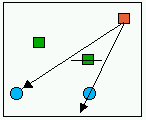 |
You can be a more effective goalie when there is at least one of your
team mates around to help. There will usually be at least one other
member of your team chasing the person with the ball, and if your
team mate is successful there won't be a shot for you to defend.
If you are playing with very experienced players then their instincts
and experience will be enough to make your job easier. If you are
playing with someone who knows how to skate but doesn't know much
about rollersoccer you can sometimes position them in a manner which
makes your job easier. I call it the "strong side defense". In this
strategy one of your players takes a position on one side of the goal
ahead of where you position yourself. Their whole purpose is to
make that side less attractive to your opponents, encouraging them
to always maneuver to the other side. Doing so forces them into
a less desirable position because shots from the side are less likely to
score because the goal appears to be smaller to them. If they
try to maneuver to where your defender is positioned then they have
to deal with your defender. If nothing else this complicates things
for your opponent and reduces their chances of scoring from that
side.
The strong side defense has some weaknesses:
- The defender may not be very effective and may let the opponent
through, in which case you are out of position. To handle this risk
you must follow the opponent if they take on your defender -- don't
stay on the "weak side". If anything, you only shift toward the
weak side a few feet and you must always ready to abandon the strategy
since it can break down quickly.
- The defender may block your visibility. You can't defend against
what you can't see. To handle this risk you must move your head around
side to side and shift your position slightly but quickly to maintain
visibility. Also, focus on the ball! You can usually see the ball
even when you can't see much of the opponent.
- The defender may deflect a shot on goal. A deflected shot is very
hard to defend against because you just don't have time to adjust. There
isn't much you can do about this risk, but quick reflexes and good body
position helps.
|
Finally, sometimes (rarely, but it happens) you will actually be in
the best position after someone takes a shot on goal (which you have
blocked) to take the ball down the field and take a shot on your
opponents goal! This happens when the entire other team has charged
your goal area leaving them all out of position to defend. Chances
are good that most of your team are covering the other players too,
leaving the entire field open in front of you. Since you are good
at exploding forward and aren't winded the way the rest of the other
players are you can take the ball forward and before anyone can do
anything about it you have a one-on-one with the other goalie. A
one-on-one is a situation they should be able to defend against,
but it is worth trying because they won't be expecting it and they
also won't have much of an idea about what kind of a player you are,
whether you go left or right, will or won't fake, fake once, fake
twice, etc. In other words, the other goalie is starting with no
idea about what kind of a shot you will be taking. You'll have a
lot of speed by the time you reach the other side, because if you
don't you'll allow their defenders a chance to catch up to you.
So you'll be moving very fast, leaving you time to roll for the
last 15 feet or so. During this time you can choose your shot,
make some fancy foot fakes and look for any opportunity, such
as the other goalie being out of position. Also, at that speed
you can shift to the side much quicker than a skater at a
slower speed. So you can approach from one side and shift to the
other side quickly at the last moment to take your shot. Be careful
not to run into the other goalie!
If you do make a fast break like this it is up to your team to
cover the goal for you. If you miss your shot and the other
goalie blocks the ball you are completely out of position and
won't be able to get back in time to do any good. Usually someone
from your team will already be covering the goal, but it never hurts
to shout out "someone cover goal" when you make a fast break.
|